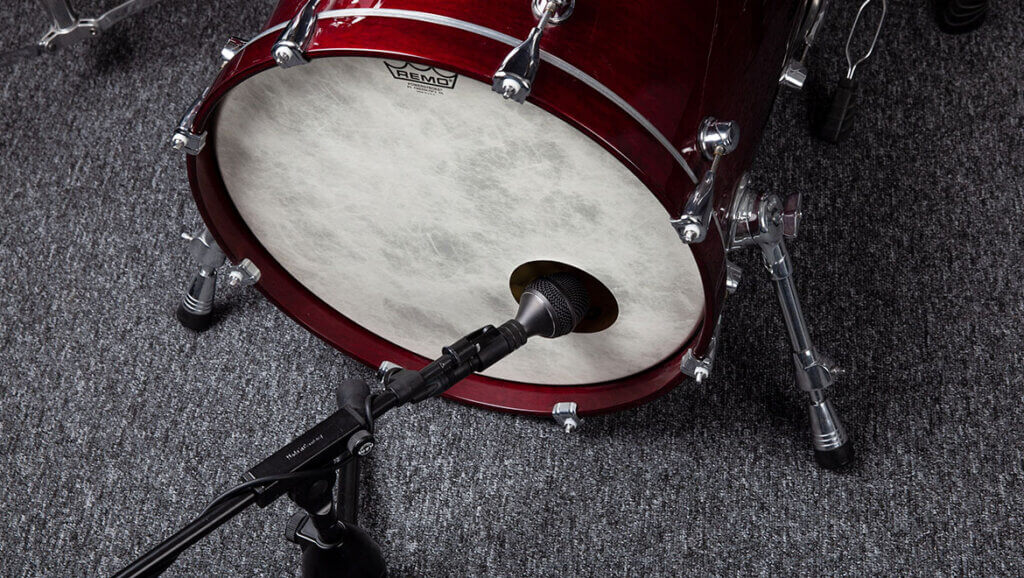We were delighted when the recently released DPA 4055 Kick Drum Microphone showed up for review earlier this spring. Having a dedicated mic on the kick is a huge time-saver when it comes to recording, since you’re not shuffling other mics around from your locker, or repurposing mics that weren’t really designed to handle the high demands of a punchy kick.
Setup is a breeze with the 4055 ― since it’s a condenser, we just fed it 48V via our SSL interface and tested it in a few different common alignments. We’ve recorded kick drums with large dynamic mics in the past, which yielded decent results.
With the 4055, first we placed it on a low stand with the capsule right up inside the bass drum, but not so close to the beater on the other side that we were in any danger of blasting out our preamp. Depending on the genre you’re recording, you may or may not like the way this captures the kick—going just slightly off-axis in this scenario yielded very tight, punchy results that essentially helped isolate the rest of the kit to virtually eliminate annoying (and hard to edit out) bleed-through. On-axis yielded similarly good results.
The high SPL of the 4055 means that you can really throw some heavy hitters at it without worrying too much about going red, and the flat frequency response from 20-20 means that the bass drum track in your DAW doesn’t receive any unwanted color along the way.
Next, we tested it outside of the hole, again a little off axis, just to see how it would perform. The good news is that on- or off-axis still yielded excellent results, which again makes setup time go quicker. If you’re playing with a mic to get it perfectly “on” without any weird proximity effects, that just eats up session time. If you’re going for a two-mic approach on the kick (we normally do not), you may need to spend an extra minute or two with setup to mitigate any phase issues.
All in all, we gave the 4055 a decent workout in about four different positions on the kick, depending on whether we wanted to get boomy, tight and punchy, or to capture the snap of the beater along with some of the room and kit. In every setup, the 4055 performed like a champ. Mixing it in with overheads and a room mic on the kit was easy, especially without the 4055 sticking out or (again) adding any dis-harmonious color to the other mics. In short, it all gelled together like we wanted without any fuss. Sometimes the biggest selling point is when something simply works like you need it to. Those are the pieces that quickly become go-tos.
We must say, the 4055 is also pretty rugged. Based on what we saw in the studio, it can easily handle road duties as well. Even better, just for fun, we tried it on some guitar cabs,― both close-mic’d on- and off-axis, as well as backed off for a little ambience, mixed in with our go-to SM57 close on the speaker cone. Results here were, as expected: fantastic. The whole sonic spectrum of the guitar (in this case a Les Paul through a pair of Celestion Vintage 30s) was captured with intense detail — in a word: you felt like you were there, front-row.

Both clean and pushing the preamp tubes hard with distortion, as well as lowering the preamp gain and pushing the power amp section tubes into overdrive, the 4055 just got every bit of detail. And, as you’re probably tired of hearing, no unwanted color. For us, that’s killer because the mid-hump we usually want for guitars to cut through should come from the amp or EQ in mixing, and if your mic is futzing with the frequencies at the source, that can be difficult to get right later on.
Ultimately, the 4055 features an open cardioid pattern, which might be a little different than what you’re used to for kick mics, but you can’t argue with results. The $765 price tag might seem a bit high at first if you’re only used to more budget-friendly dynamic options, but keep in mind this mic can do double duty in the studio and on tour, while also serving as a great cabinet mic for your guitars. We thought it sounded fantastic and was built tank-tough, so we absolutely give it our recommendation.
Add it to your mic locker and hear for yourself!
Pros:
Excellent sound, easy to position, versatile for non-drum applications too.
Cons:
None.
Street Price:
$765
